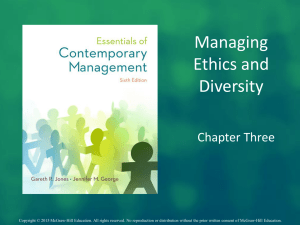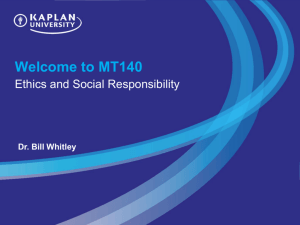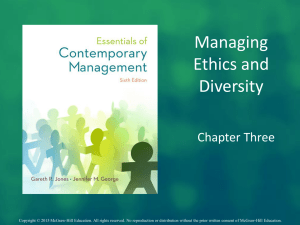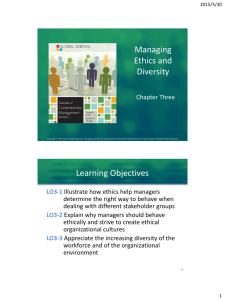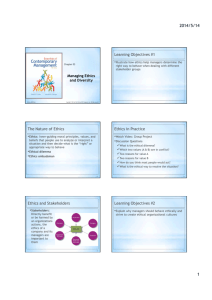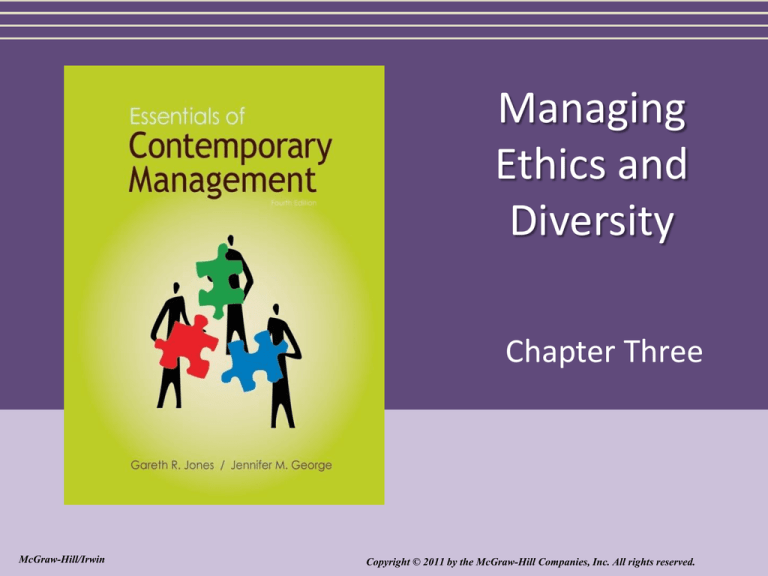
Managing
Ethics and
Diversity
Chapter Three
McGraw-Hill/Irwin
Copyright © 2011 by the McGraw-Hill Companies, Inc. All rights reserved.
Learning Objectives
LO1 Illustrate how managers use ethics to
determine the right or proper way to
behave when dealing with different
stakeholder groups
LO2 Explain why managers should strive to
create ethical organizational cultures
LO3 Appreciate the increasing diversity of the
workforce and of the organization
environment
3-2
Learning Objectives (cont.)
LO4 Grasp the central role that managers play in
the effective management of diversity
LO5 Understand why the effective management
of diversity is both an ethical and business
imperative
LO6 Understand the two major forms of sexual
harassment and how they can be
eliminated
3-3
The Nature of Ethics
• Ethical Dilemma
– Quandary people find themselves in when they
have to decide if they should act in a way that
might help another person even though doing so
might go against their own self-interest
3-4
The Nature of Ethics
• Ethics
– The inner-guiding moral principles, values, and
beliefs that people use to analyze or interpret a
situation and then decide what is the “right” or
appropriate way to behave
– Personal, Social, Professional
3-5
Stakeholders and Ethics
• Stakeholders
– The people and groups that supply a company
with its productive resources and so have a claim
on and stake in the company
3-6
Types of Company Stakeholders
Figure 3.1
3-7
Stockholders
• Want to ensure that managers are behaving
ethically and not risking investors’ capital by
engaging in actions that could hurt the
company’s reputation
• Want to maximize their return on investment
3-8
Managers
• Responsible for using a company’s financial
capital and human resources to increase its
performance
• Have the right to expect a good return or
reward by investing their human capital to
improve a company’s performance
• Frequently juggle multiple interests
3-9
Discussion Question: Managers
A.
B.
C.
D.
Is it ethical for managers to receive vast
amounts of money from their companies?
Yes
No
Sometimes
Never
Other Peoples Money and Lehman Brothers
3-10
Employees
• Companies can act ethically toward
employees by creating an occupational
structure that fairly and equitably rewards
employees for their contributions
3-11
Suppliers and Distributors
• Suppliers expect to
be paid fairly and
promptly for their
inputs
• Distributors expect
to receive quality
products at agreedupon prices
3-12
Customers
• Most critical
stakeholder
• Company must work
to increase efficiency
and effectiveness in
order to create
loyal customers and
attract new ones
3-13
Community, Society, and Nation
• Refers to physical locations like towns or cities
or to social milieus like ethnic neighborhoods
in which companies are located
• Provides a company with the physical and
social infrastructure that allows it to operate
3-14
Ethical Decision Making
Figure 3.2
3-15
Practical Decision Model
1. Does my decision fall within the acceptable
standards that apply in business today?
2. Am I willing to see the decision
communicated to all people and groups
affected by it?
3. Would the people with whom I have a
significant personal relationship approve of
the decision?
3-16
Why Should Managers Behave Ethically
The relentless pursuit of self-interest can lead
to a collective disaster when one or more
people start to profit from being unethical
because this encourages other people to act in
the same way.
Can you think of any Examples??
Management at Enron, Bernard Madoff
3-17
Some Effects of
Ethical/Unethical
Behavior
Figure 3.3
3-18
Question?
What is confidence and faith in another person’s
goodwill?
A. Reputation
B. Trust
C. Empathy
D. Hope
3-19
Why Should Managers Behave Ethically
• Trust
– Willingness of one
person or group to
have faith or
confidence in
another person’s
goodwill, even
though this puts
them at risk
• Reputation
– Esteem or high
repute that
individuals or
organizations gain
when they behave
ethically
3-20
Ethical Organizational Cultures
• Managers can ensure that
important ethical values and
norms are key features of an
organization’s culture
• Managers become ethical
role models whose behavior is
scrutinized by their subordinates
http://www.youtube.com/watch?v=vH1qFZW2_OI
3-21
Ethical Organizational Cultures
• Ethics Ombudsman
– An ethics officer who monitors an organization’s
practices and procedures to be sure they are
ethical
3-22
The Increasing Diversity of the Workforce
and the Environment
• Diversity
– Differences among people in age, gender, race,
ethnicity, religion, sexual orientation,
socioeconomic background
and capabilities/disabilities
http://www.youtube.com/watch?v=HY5XmSyIJa8
3-23
Diversity Concerns
• The ethical imperative for equal opportunity
• Effectively managing diversity can improve
organizational effectiveness
• The continuing bias toward diverse individuals
3-24
Question?
What is the metaphorical barrier that
prevents minorities and women from being
A.
B.
C.
D.
promoted to top corporate positions?
Gender Barrier
Gender Prejudice
Glass Ceiling
Glass Top
3-25
Diversity Concerns
• Glass ceiling
– A metaphor alluding to the invisible barriers that
prevent minorities and women from being
promoted to top corporate positions
3-26
Sources of Diversity in the Workplace
Figure 3.6
3-27
Workforce Diversity: Age
• Aging U.S. Population
– By 2030, 20 percent of the population will be over
65
• Federal Age Discrimination Laws
– 1964
– 1967
Title VII of the Civil Rights Act of 1964
Age Discrimination in Employment Act
3-28
Workforce Diversity: Gender
• Women in the Work Place
– U.S. workforce is 46.5 % percent female
– Women’s weekly median earnings are $572
compared to $714 for men.
– Women hold only 16% of corporate officer
positions
– http://en.wikipedia.org/wiki/
Danica_Patrick
3-29
Workforce Diversity: Religion
• Accommodation for Religious Beliefs
– Scheduling of critical meetings
– Providing flexible time off for holy days
– Posting holy days for different religions on the
company calendar
3-30
Workforce Diversity: Capabilities and
Disabilities
• Disability Issues
– Providing reasonable accommodations for
individuals with disabilities
– Promoting a nondiscriminatory workplace
environment
– Educating the organization about disabilities and
AIDS
3-31
Workforce Diversity: Socioeconomic
Background
• Socioeconomic Background Issues
– Widening diversity in income levels
– Single mothers and the “working poor”
– Child and elder care
for working parents
3-32
Workforce Diversity: Sexual Orientation
• Sexual Orientation Issues
– Employment and workplace discrimination
– Provision of domestic-partner benefits
3-33
Critical Managerial Roles
• Managers have more influence than rank-andfile employees
• When managers commit to diversity, it
legitimizes diversity efforts of others
3-34
Forms of Sexual Harassment
• Quid pro quo
– Asking or forcing an employee to perform sexual
favors in exchange for some reward or to avoid
negative consequences
– “This for that”
3-35
Forms of Sexual Harassment
• Hostile work environment
– Telling lewd jokes, displaying pornography, making
sexually oriented remarks about someone’s
personal appearance, and other sex-related
actions that make the work environment
unpleasant.
3-36
Steps to Eradicate Sexual Harassment
• Develop and clearly communicate a sexual
harassment policy endorsed by top
management
• Use a fair complaint to investigate charges
of sexual harassment
3-37
Steps to Eradicate Sexual Harassment
• When it has been determined that sexual
harassment has taken place, take corrective
action as soon as possible
• Provide sexual harassment education and
training to all organizational members,
including managers
3-38


